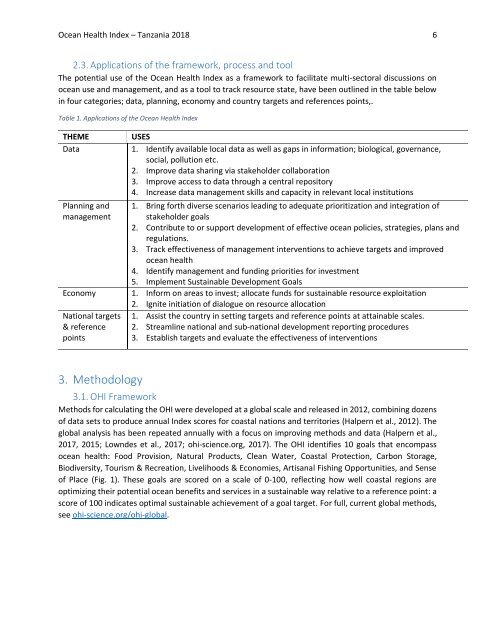OHI+ Tanzania_Technical Report_2018
You also want an ePaper? Increase the reach of your titles
YUMPU automatically turns print PDFs into web optimized ePapers that Google loves.
Ocean Health Index – <strong>Tanzania</strong> <strong>2018</strong> 6<br />
2.3. Applications of the framework, process and tool<br />
The potential use of the Ocean Health Index as a framework to facilitate multi-sectoral discussions on<br />
ocean use and management, and as a tool to track resource state, have been outlined in the table below<br />
in four categories; data, planning, economy and country targets and references points,.<br />
Table 1. Applications of the Ocean Health Index<br />
THEME<br />
Data<br />
Planning and<br />
management<br />
Economy<br />
National targets<br />
& reference<br />
points<br />
USES<br />
1. Identify available local data as well as gaps in information; biological, governance,<br />
social, pollution etc.<br />
2. Improve data sharing via stakeholder collaboration<br />
3. Improve access to data through a central repository<br />
4. Increase data management skills and capacity in relevant local institutions<br />
1. Bring forth diverse scenarios leading to adequate prioritization and integration of<br />
stakeholder goals<br />
2. Contribute to or support development of effective ocean policies, strategies, plans and<br />
regulations.<br />
3. Track effectiveness of management interventions to achieve targets and improved<br />
ocean health<br />
4. Identify management and funding priorities for investment<br />
5. Implement Sustainable Development Goals<br />
1. Inform on areas to invest; allocate funds for sustainable resource exploitation<br />
2. Ignite initiation of dialogue on resource allocation<br />
1. Assist the country in setting targets and reference points at attainable scales.<br />
2. Streamline national and sub-national development reporting procedures<br />
3. Establish targets and evaluate the effectiveness of interventions<br />
3. Methodology<br />
3.1. OHI Framework<br />
Methods for calculating the OHI were developed at a global scale and released in 2012, combining dozens<br />
of data sets to produce annual Index scores for coastal nations and territories (Halpern et al., 2012). The<br />
global analysis has been repeated annually with a focus on improving methods and data (Halpern et al.,<br />
2017, 2015; Lowndes et al., 2017; ohi-science.org, 2017). The OHI identifies 10 goals that encompass<br />
ocean health: Food Provision, Natural Products, Clean Water, Coastal Protection, Carbon Storage,<br />
Biodiversity, Tourism & Recreation, Livelihoods & Economies, Artisanal Fishing Opportunities, and Sense<br />
of Place (Fig. 1). These goals are scored on a scale of 0-100, reflecting how well coastal regions are<br />
optimizing their potential ocean benefits and services in a sustainable way relative to a reference point: a<br />
score of 100 indicates optimal sustainable achievement of a goal target. For full, current global methods,<br />
see ohi-science.org/ohi-global.


















